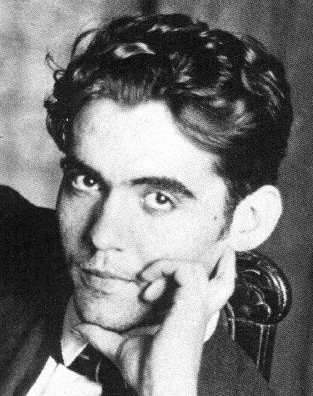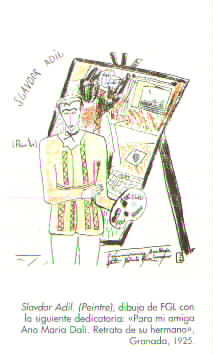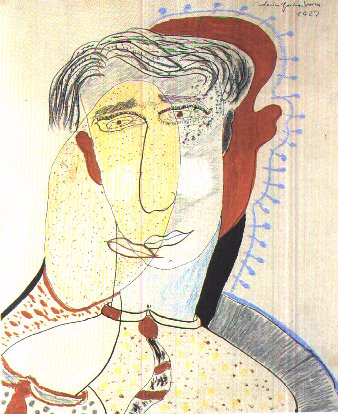

 |
 |
|
|
Verde viento. Verdes ramas. El barco sobre la mar y el caballo en la montaña. Con la sombra en la cintura ella sueña en su baranda, verde carne, pelo verde, con ojos de frío plata. Verde que te quiero verde. Bajo la luna gitana, las cosas la están mirando y ella no puede mirarlas. |
| Translation: Green how I love you green./Green wind. Green branches./The ship on the sea/and the horse on the mountain./With the shadow at her waist,/she's dreaming at her balustrade,/green flesh, green hair,/with eyes of cold silver./Green how I love you green./Under a gypsy moon,/the things are looking at her/and she cannot look at them. |
|
|
|
|
|
|
|
|
|
|
|
|
|
|
|
|
|
|
|
|
|
|
|
|
|
|
|
|
|
|
|
|
|
|
|
|
|
|
|
|
|
|
|
|
|
|
|
| "Dates written" is problematic: Lorca often dated his work as finished, though he had been working on it for some time before and he might continue to make minor "corrections" up to the date of its publication. |
| Oda a Salvador Dalí | April 1926 |
|
Ten of the eighteen Gypsy Ballads were published as single poems before the collection was published in 1928. |
. |
| 1. Romance de la luna luna | Jun 1925; Apr 1926; Jul 1927 |
| 2. Preciosa y el aire | November 1926 |
| 3. Reyerta | Oct 1926; Jun 1927 |
| 6. La casada infiel | January 1928 |
| 8. San Miguel (Granada) | November 1926 |
| 11. Prendimiento de Antoñito el Camborio | November 1926 |
| 13. Muerto de amor | October 1927 |
| 14. El emplazado | January 1928 |
| 16. Martirio de Santa Olalla | January 1928 |
| 17. Burla de Don Pedro a caballo | June 1927 |
| These published poems along with the readings Lorca had given served to create great expectations prior to the publication of the collection in 1928. |
|
| Oda al Santísimo Santo (fragments) | December 1928 |
| Soneto: Yo sé que mi perfil será tranquila | Apr 1930; Dec 1932 |
| Of the 34 poems finally published in the collection Poeta en Nueva York, a number were published in the course of the 1930s, including:- | . |
| In Cuba.Danza de la Muerte; Son (de negros en Cuba) | April/May 1930 |
| In Revista de Occidente: Vaca; Muerte; Ruina; New York (oficina y denuncia)) | January 1931 |
| In Los cuatro vientos: Oda al rey de Harlem | February 1933 |
| In Mexico: Oda a Walt Whitman | August 1933 |
| In London: Pequeño vals vienés; Paisaje con dos tumbas y un perro asirio | 1934; 1935 |
| In all, I count 18 published poems from the finally published collection. | . |
| Soneto: Adam | 1932; 1933; 1936 |
| Casida de las palomas oscuras (from Diván del Tamarit) | 1932 |
| Gacela de la raíz armarga (from Diván del Tamarit) | 1933 |
|
|
for links to original versions of Lorca's poetic works, as well as to several English translations, including my own |

|
 |
On May 26, 1916, Antonio Segura, Lorca's music teacher, died. Lorca wanted to continue his music studies in Paris, but his father would not let him. Lorca's creative instinct turned to poetry. On June 29, 1917, he wrote his first poem "Canción. Ensueño y confusión". In the following months, Lorca wrote hundreds of poems. With the help of his brother, Francisco, 67 poems were selected for this first book, published in May 1921. They were, the poet admitted in the preface to the book, far from perfect; they were the product of "juvenile ardour" and "limitless ambition" and were the "true reflection of his adolescent heart and youthful spirit". |

|
|
To purchase this book, click the title above |
| To purchase this book, click the title above |
| His love for music and for the popular tradition were also sources of inspiration for the poems (written between 1921 and 1924) included in these two books (published in 1936 and in 1927 respectively). | The publication of Canciones in 1927 did much to establish Lorca's reputation as one of the new generation of Spanish poets whose work came to be recognised as a new Golden Age in the history of Spanish Literature. |
| To purchase this book, click the title above |
Lorca and Dalí met in Madrid in January 1923 and were immediately attracted to each other. The friendship deepened and at Easter 1925 the poet visited the painter's family in Cadaqués, Catalonia. Shortly after, he began writing this ode which elogises Dalí's personality as well as his artistic style and convictions. |
 |
Digo lo que me dicen tu persona y tus cuadros. No alabo tu imperfecto pincel adolescente, pero canto la firme dirección de tus flechas. Oh Salvador Dali with the olive voice!
(The translation is mine.)
|

Apparition of a Face and Fruit Dish on a Beach, 1938 Dali, Salvador Buy this Art Print at AllPosters.com |

Honey is Sweeter than Blood Dali, Salvador Buy this Art Print at AllPosters.com |
If you want to buy a collection that contains this poem, click the title
| To purchase this book, click the title above |
An audio CD is also available, containing all the best known romances from this collection, in Spanish. |
| Lorca was deeply affected by the rupture with Dalí and he entered
into a period of depression that lasted from 1928 to 1930.
Lorca's father was convinced that his son needed "a change of air" and
the trip to New York, accompanied by friend of the family, Fernando de
los Ríos, later Socialist Minister in the Republican Government,
was arranged. The poet's confrontation with the great metropolis, combined
with his heightened sensibility, gave rise to this exceptional collection
of poems, in which surrealist elements are used to give expression to a
harsh reality, passionately experienced. The book is often cited as one
of the major poetic achievements of the Twentieth Century.
Opposite: Self portrait of Lorca in his New York period. |
|
| To purchase this book, click the title above |
top of page |
| Through the groves of the Tamarit
the dogs of lead have come From Casida de los ramos" |
The rose
wasn't looking for the dawn From Casida de la rosa |
| Through the Arch of Elvira
I want to watch you go by, From Gacela del mercado matutino |
Just because I heard
the bell of the Vela From Gacela del amor que no se deja ver |
| To buy a collection of Lorca's works that includes this poem, click the title |
| To buy a collection of Lorca's works that includes this poem, click the title. An audio CD of this poem, read in English by Germaine Montero, is also available. |
In 1932, on his travels through Spain giving lectures for the Republican
Committees for Intellectual Cooperation and with his student travelling
theatre group, La Barraca, Lorca visited Galicia, the region in the northwest
corner of the peninsula. Later in the year, he started writing poems in
the regional language.
With the help of the Galician poet Eduardo Blanco-Amor, who he met
the following year, Lorca's six Galician poems were prepared for publication,
in December 1935.
top
In 1933, reconciled by now to his homosexual condition, Lorca met and fell in love with Rafael Rodríguez Rapún, who worked as a secretary to the Barraca student travelling theatre group that he directed. In 1935 and 1936 this relationship gave rise to these 11 love sonnets, which are undoubtedly (in the words of fellow Andalusian poet, Vicente Aleixandre,) "a prodigy of passion, of enthusiasm, of happiness, of torment", a pure and ardent testimony to his love and to his suffering. Opposite: El beso. 1927. If you want to buy a book of the best sonnets in the Spanish language, click the title |
 |

|
|
for links to original versions of Lorca's poetic works, as well as to several English translations, including my own |
